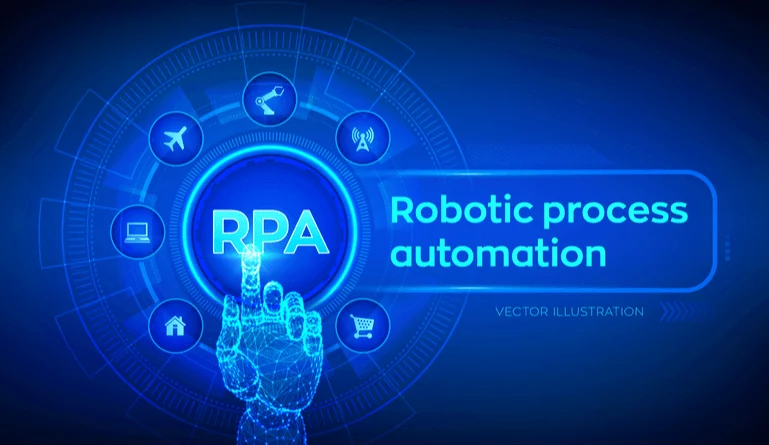It is not wrong to say the pandemic has pushed the global business ecosystem into dismay, forcing companies to accept the ‘Save to Thrive’ approach instead of the “save to transform” approach. This catastrophe primarily impacted companies’ talent resources, underscoring crucial transformation initiatives such as robotic process automation (RPA). The induction of RPA is one such paradigm shift that can help businesses survive once the virus is contained and the new normal emerges.
RPA can not only help businesses save money on human resources as businesses scale, but it can also help them avoid the repercussions of human error. In addition to the money, RPA frees up a lot of time for the company’s current staff, allowing them to focus on higher-value duties and recover time lost due to lockdowns.
RPA can boost a team’s capacity for completing work by 35 percent to 50 percent when effectively configured for a workflow.
What is Robotic Process Automation?
Robotic process automation (RPA) is a game-changing technology for automating corporate processes. RPA is a tool that relieves employees of low-value, repetitive and tedious jobs.
Companies that use RPA can allow employees to take more responsibility and perform activities that add value, instead of involving them in a procedure that a BOT might manage. RPA’s are designed to mimic or replace human user behavior. An RPA automates and repeats pre-defined operations which are much faster than human users because they are automated.
To be promising and advantageous for a company’s success, RPA merely requires an adequate design, strategy, and governance following established methods.
How Does Robotic Process Automation Work?
- First, they log into the software, systems, and applications
- They connect to system APIs
- They transfer folders and documents
- They copy and paste data
- They fill in forms
- They extract and analyze structured and semi-structured content from a variety of sources such as emails, PDFs, scrape browsers, documents, etc.
- They read and rewrite to databases
- They open emails and attachments
- They scrape data from the internet
- Finally, they make calculations.
Why RPA is Important for Your Business?
Without doubts, robotic process automation is increasingly getting more and more important in the growth of businesses, especially the manufacturing industry which was one of the first to embrace the functions of automation. Primarily, the major importance of RPA for `your business is in the enhancement of productivity and efficiency of your employees. `
In fact, it has been forecasted that RPA and other automation technologies could have a financial value of about $6.7 trillion by 2025. You see now that the potential importance of RPA to your business should not be undermined. Below, we have elaborated on some of this importance.
-
RPA supports businesses in their journey of digital transformation
Thanks to robotic process automation, businesses can now advance their digital dreams to a higher level that they never imagined they could attain before. Indeed, RPA is a vital element in digital transformation. It extends beyond the automation of repetitive and tedious tasks and ensuring there is standardization all through the business processes.
Businesses can now utilize RPA to boost their digital journey more than ever. RPA empowers them to concentrate on enhancing their digital efforts in enterprise projects, as well as maximizing customer-oriented experiences. RPA is indubitably a key factor in the digital transformation strategy of any business.
Furthermore, a lot of businesses are continuously pumping investments in automation technology and cognitive intelligence projects. As a result, they have been positioned to have a competitive edge over other organizations in the same industry by digitizing processes, enhancing productivity, and developing innovative solutions that result in business-wide transformation.
-
It prepares businesses for a data-driven market
Big data is a subject that can not be overlooked, especially with the increasing transition of businesses to a data-propelled market. However, many enterprises are faced with the challenge of a high volume of data. Streamlined processes, accurate utilization of data, and a seamless exchange of data can be useful in the enhancement of the overall customer experience.
It is pertinent to expound that data integrated with automation functionalities is a disruptive technology that has the capacity to quickly digitize processes and provide relevant value to the enterprise and its customers. RPA can monitor and manage the high volume of unstructured data that is out there – from data capturing and processing to data interpretation.
It leverages this process to assist employees in the making of well-informed decisions. The transition to a data-oriented business will assist businesses to abandon traditional RPA methods, legacy systems, and process huge volumes of data in split seconds.
-
It helps you to unleash the capabilities of intelligence
As a business owner or manager, have you ever implemented Artificial Intelligence or Machine Learning in your business processes? Have you ever considered extending your scope beyond robotic process automation? At first, businesses that adopt RPA start with the automation of rule-dependent projects.
Gradually, they progress onto projects that require a combination of predictive models and NLP, concentrating on judgment and intelligence for decision-making.
It has been observed that a lot of businesses are open to implementing artificial intelligence and/or machine learning functions in their enterprise processes. This explains why humans and smart robots are working and cooperating together more than ever before. As a result of this close interaction, there is a monumental shift in the way enterprises operate.
-
RPA heralds digitized workers in your business
The presence of robotic process automation also brings about the introduction of a virtual or digital workforce. This is where bots or digital workers work together and foster collaboration with the human employee, thereby allowing the human to concentrate on more imperative projects.
It is the role of the digital workers to imitate human behaviors and execute time-consuming, repetitive procedures like employee onboarding, e-invoicing, and internal reporting, among many others.
The development and management of a digital workforce demands a conspicuous automation blueprint and reprogramming the mindset of the employee. Ultimately, the combination of automation and AI has introduced an era of a new digital workforce, which rescues humans from monotonous projects and supports them to engage in more productive tasks.
Types of Robotic Process Automation
Basically, there are 3 types of RPA, which are:
-
Attended Automation
Typically, attended automation is most often described as the kind of RPA that operates on the computer of the user. However, this is very much off the point for those businesses whose aim is the automation of their processes.
Although it is accurate that attended robotic systems are incorporated into the laptop or desktop of an employee, it remains that the most unique element of attended automation is the fact that each robotic system has been programmed for a specific user.
The robot will always be available whenever a worker wants a robot to execute a procedure. All the employee has to do is activate the functions of the robot so as to benefit from the time-saving features and accuracy of automation.
With more advanced technology, it is possible for the robot to be activated automatically by predefined user behavior. For instance, in order to make sure that each customer service representative manages customer data adequately, a call center may decide to develop rules that will ensure this.
Thus, whenever an employee is non-compliant with any of these rules, one of the attended robots can do either of two actions. One, it may automatically execute the predefined procedure for the employee. Or it may simply send a message notifying the employee of their error or mistake.
-
Unattended Automation
Basically, unattended automation can be described as automation that runs on a virtual machine. However, it does not meet the point from the perspective of an enterprise user. As a business owner who is interested in RPA, it is very imperative to understand that each unattended robot, in unattended automation, is designed to carry out procedures for multiple employees.
As opposed to being deployed by a particular user or automatically activated by an activity on a user’s system, an unattended robot has the capacity to execute procedures that are delegated to it according to a defined schedule, an API, or a predefined event.
Perhaps the most significant benefit of unattended automation is that, since each robot is operated on a virtual machine, this does not stop users from continuing to carry out their jobs on their own computers.
As a result of this advantage, coupled with the ability of unattended robots’ to perform processes allocated to them from several sources, unattended automation is usually considered as a more preferable solution than attended automation for essential procedures that take a long time to operate.
A practical example can be examined in an important organization’s finance and accounting department that wants to process a huge amount of received invoices. Definitely, unattended automation would be the best solution for them to sign up for.
-
Hybrid automation
At the end of the day and despite the varying advantages of attended and unattended robots, the fact is that even the fastest robots take a relatively long period of time to complete certain processes (although usually far less amount of time than a full-time employee would take to have them done).
With Hybrid automation, the attended robot carries out the aspects of that project that demands the involvement of a human worker, while an unattended robot operating on a virtual machine carries out the rest of the project. Thus, hybrid automation becomes a very versatile option since the interaction between attended and unattended robots goes in both directions.
In fact, depending on the project at hand, an employee can launch a project by triggering their attended robot – and then the attended robot can activate the unattended robot to execute the remaining phase of the work.
In some other cases, the unattended robot can begin carrying out a task when triggered by an API, an event, or a schedule – and whenever this unattended robot requires the employee to determine a decisive step, it transfers the work to the attended robot, which consequently notifies the employee to execute the phase of the task that requires the input of a human worker.
In essence, hybrid automation can have a more complex task being transferred several times between the attended and unattended robots. Overall, hybrid automation enables the user to automate as much of the work as needed – without having to surrender the access to their computer for the whole duration of a robot’s activeness.
What Processes are Significant to RPA?
-
Quick implementation, quick ROI generation
A particular HR service provider in Europe was handling 2,500 sick leave certificates every month with an average processing time of 4 minutes per file. In 3 weeks, the company adopted an RPA solution and realized 90% process automation. What the RPA robot does is to extract information from a transaction in SAP, insert the data into the system of the customers, and then have it printed.
Eventually, the result of this RPA implementation for the HR service provider was ROI achieved in six months, with processing time reduced by 80%, manual effort reduced to 5%, and rates of error reduced to 0%.
-
Decrease effort in the back office
A certain global retailer was utilizing its store closing reports to verify closing data for each of its registers from hundreds of stores. At first, the employees at the store employed a slow and manual approach to gathering these reports.
However, through process automation, the store was able to relieve its employees to now concentrate on more customer-oriented activities. Now, the RPA robots are responsible for moving the closing reports to one server, then processing and consolidating the required data for the closing reports of the store.
-
Enhance customer service in the front office
A trade credit insurance organization with more than fifty thousand clients all across the globe decided to automate the credit limit demand underwriting process. Previously, underwriters resorted to manual methods to gather data from internal (Risk & Policy) to external (Google News, Customer Site) sources.
Thanks to the adoption of Robotic Process Automation, they were able to save 2,440 hours of human labor per month. Now, employees make use of that time to interact with the customers directly.
What are the Business Benefits of RPA?
-
Improve Productivity in each Department
The benefits of RPA automation are based on a simple theory that lets humans focus on their strengths while robots tackle the jobs that get in the way. With RPA professionals can work at a faster pace, cutting data processing time to half. Humans and robots share low-level and back-office work activities, allowing businesses to do more in the same amount of time.
-
Increase efficiency to save money
More productivity is required for a variety of reasons, including preventing humans from wasting too much time on repetitive jobs. An RPA in a department like accounts payable or receivable, where employees must routinely translate data from many portals into your company systems has proved highly effective.
It has resulted in a drop in processing costs and per-employee output rises. RPA also reduces processing times and eliminates costly errors.
-
With Reliable Consistency, Achieve Accuracy Goals
Imagine a reward of human error completely negated from some of the company’s most crucial workflows. Accounts payable discrepancies are prevalent, resulting in real and unanticipated costs for a company. Due to a transposed digit in a PO number, the company may face double payments as a result of invoices that the team unintentionally duplicated. When this gets automated automate, achieve 100 percent error-free data accuracy can be achieved.
-
Improve Your Customer Service Experience
Customer service is a high-commitment procedure that necessitates a significant amount of time and focus of employees. RPA is gaining grip in customer service, particularly where AI-powered language processing meets with technology. The main advantage in this domain now is less staff participation with repetitive activities.
Consumer happiness will rise as resolution times improve, disagreements decrease, and overall customer pleasure with your organization improves.
-
Reap The benefits of Growth Opportunities
In workflows with irregular volumes, RPA has a distinct advantage. For instance, a company may receive a higher volume of orders at certain times of the year. Without automation, the company may have to engage temporary workers or reassign personnel from other tasks to manage the data. Robots can immediately scale up or down to handle any volume of work.
-
Seamlessly integrate with the existing system
Other capabilities of RPA include computations, copy-paste, scraping digital data, accessing and moving files, parsing emails, logging into programs, connecting to APIs, and extracting unstructured data are all capabilities of bots. It is needless to alter corporate systems, applications, or existing processes to automate because bots can adapt to any interface or workflow.
( Also Read: Benefits of RPA and Its Challenges )
RPA Challenges
Even though RFA is the fastest expanding industry, it faces the following constraints:
- Many businesses are still perplexed as to how they may use it to improve their processes. Only 3% of companies have expanded their digital workforce. (Global Deloitte RPA Survey)
- The most significant barrier to RPA adoption is a lack of internal and IT resources, which is followed by employee opposition, process fragmentation, a lack of clear vision, implementation costs, data preparation, and finally, fear of disruption. (Economy of Acceleration)
- Organizations usually misjudge the time and expense of implementing RPA. 63 percent indicated their implementation time expectations were not fulfilled, and 37% said their implementation cost expectations were not met. (Global Deloitte RPA Survey).
Sectors of RPA implementation and Integration
Across a wide range of businesses and processes, RPA is creating new improvements and freeing employees from repetitive monotony. RPA has been applied in departments as diverse as finance, compliance, legal, customer service, operations, and IT. It is being implemented by companies ranging from financial services to healthcare to manufacturing to the public sector to retail and far beyond. And that’s only the beginning.
RPA has gained popularity due to its broad adaptability and utility. Almost any high-volume, business-rules-driven, repeatable activity is a fine fit for automation. Also, cognitive operations that demand higher-order AI skills are integrating themselves with RPA.
The reason why is RPA the world’s fastest-growing enterprise software
One of the key reasons is that RPA is a technology that liberates workers from having to perform repeated jobs that are sometimes monotonous and unproductive. In 2018, sales from RPA software increased by 63 percent to $846 million, making RPA the fastest-growing section of the worldwide enterprise software market.
Another key reason for its popularity is that employees now use a greater number of tools than in past years. By bridging the gaps between the systems, RPA makes it possible to automate all of these tools and their interactions.
What Industries Use RPA?
-
Business Process Outsourcing
Business Process Outsourcing (BPO) companies have taken interest in RPA because it enables them to maximize their capacity, improve operational agility, enhance SLAs, and reduce cost.
-
Financial Services
RPA enables the swift automation of data validation and migration between banking apps, and financial claims processing, form filling, reporting, and customer account management.
-
Healthcare
In healthcare, RPA reduces the stress of administration through the automation of healthcare processes such as storage, processing, patient data migration, claim processing, insurance data, and medical bill.
-
Insurance
RPA automates the process of creating a document by gathering from several data sources and using document templates to generate complex legal documents, extensive reports, and many more.
-
Life Sciences
Here, RPA enhances productivity and increases quality, and at the same time maintaining cost so that you can realize better patient results. RPA improves compliance, processing times, and enables effective engagement with more patients.
-
Manufacturing
Allow robotic process automation to handle the heavy lifting for product pricing comparisons, data monitoring, automation of logistics data, and ERP automation.
-
Public Sector
Thanks to RPA, governmental institutions can achieve safe, dependable automation that complies with all federal mandates. This enables government workers to concentrate on the improvement of citizen services.
-
Telecom
RPA is deployed in the collection, consolidation, and backing up of data from client phone systems, and then utilized to upload and extract information about phone manufacturing data, competitor pricing, etc.
Popular RPA Vendors
Are you thinking of which RPA vendor to choose? Below are five popular robotic process automation vendors to consider:
- HelpSystems
- Pegasystems
- Kofax Kapow
- EdgeVerve
- Automation Anywhere
Final Thoughts
New technological solutions have the potential to alter businesses, but there are numerous service providers for each use case. Even after hours of study, major solution suppliers or smaller but more innovative vendors can be easily overlooked. UiPath and Automation Anywhere besides Blue Prism Group are some of the reputed names that have successfully implemented RPA in an array of other organizations.







